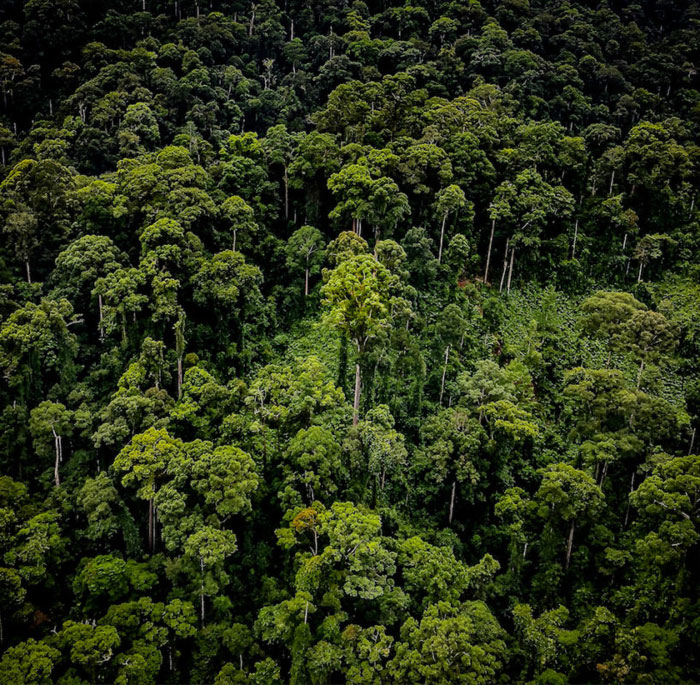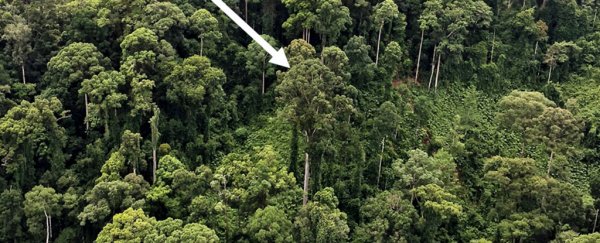Researchers have announced the discovery of the tallest tropical tree in the world, with a towering 94.1-metre (309-foot) tree in Borneo eclipsing the previous record.
In addition to finding the tallest known tree in the tropics, the research also identified the next 49 tallest trees – each of which stands greater than 90 metres (295 feet) in height – making for an unprecedented 50 record-breakers in a single haul.
To get an idea of how big these trees really are, the researchers say the tallest is about the length of six sperm whales – each approximately 16 metres (52 feet) long – lined up snout to fluke (head to tail).
"I've been doing this for a solid 20 years now, and I have to say, this was one of the most moving experiences in my career," ecologist Gregory Asner from the Carnegie Institution for Science at Stanford University told Mike Gaworecki at Mongabay.
"This tallest tropical tree, and the 49 runners-up, are truly phenomenal expressions of the power of nature."
The find comes just months after another team from Cambridge University in the UK made headlines with the discovery of a tropical tree measuring 89.5 metres (293.6 feet) in Maliau Basin, a reserve in the Bornean state of Sabah.
But Asner's team used laser scanning to find that another reserve in Sabah – called Danum Valley – contained a grove of trees with even greater stature.
The researchers identified the trees' height with an aircraft called the Carnegie Airborne Observatory, which uses a laser-based system called LiDAR (Light Detection and Ranging) that can measure and map landscapes in three dimensions.
"This technique relies on the 500,000 laser shots per second that we fire out of the bottom of the plane as we fly, which provides a very detailed 3D view of the forest canopy down to the ground level," Asner told Mongabay.
"We then digitally process and comb the 3D data for the tallest trees (in this case)."
 Greg Asner/Carnegie Institution for Science
Greg Asner/Carnegie Institution for Science
With the LiDAR data in hand, Asner returned to the area by helicopter, to make out the world's tallest tropical tree in a sea of green below.
"We aimed directly at the coordinates of the tree marked in our laser scanning data," he said. "And there it was, sticking out above the rest of the canopy."
As the tree has only been observed remotely at this point, the scientists haven't had a chance to confirm the species just yet, but it's likely to be in the genus Shorea, which encompasses almost 200 species of rainforest trees native to Southeast Asia.
Borneo is home to 130 of these species – which can live for hundreds of years – but many are endangered by logging.
To confirm the species, the team intends to visit each of the tallest 50 trees in the coming weeks – and it's fair to say that these giant specimens will make quite an impression when seen up close, much as they did when viewed from a helicopter.
"The crazy thing is that our tallest tree is immediately flanked to each side by a tree of the same species of Shorea, almost as tall!" said Asner.
"So, there are three trees, like brothers, standing above the rest of the canopy. I almost cried as we circled the tree maybe 10 times before the pilot said we had to go back."
But as staggering as that is, it's still not as tall as the tallest trees outside the tropics. The world's tallest tree anywhere – California redwoods (Sequoia sempervirens) – have been measured as high as 115.5 metres (379 feet), putting even giant Shorea in the shade.
The new study hasn't been published in a scientific journal yet, so we can't consider the claims regarding stature as having been verified until other scientists have had a chance to examine the research.
Not that cataloguing these epic trees is just some kind of scientific one-upmanship though.
Apart from measuring their physical stature, the aim of the Bornean research is to help us understand the sprawl and health of these forest populations, so that we can better defend them from threats like logging.
"Tallest tree aside, this work really highlights the value of protecting primary forests," one of the team, Glen Reynolds from the South East Asia Rainforest Research Program (SEARRP), told Kevin McLean at National Geographic.
"These ancient trees are really only found in primary forests, many of which are not properly protected. A detailed map like this will be useful for establishing conservation priorities."
So while most of the attention the team gets will probably be a result of them having stumbled upon the tallest tree in the tropics, that fact doesn't bother them in the slightest.
"Conservation needs inspiration, and these sentinels of the Bornean jungle provide that to us," Asner told Mongabay.
"This discovery is a gift to science, to the people of Sabah and Borneo, and to the world."
The findings were presented at the International Heart of Borneo Conference 2016 last week.
